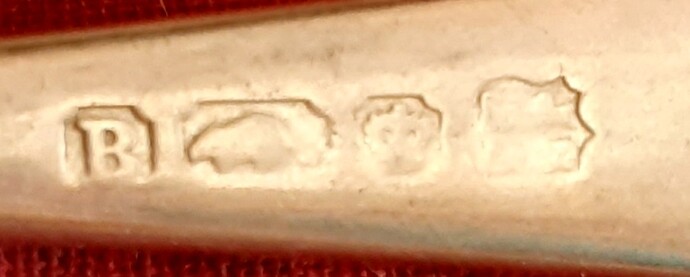Good day, friends! I have here a fork which under normal circumstances I would not be interested in commenting on. But it seems the fork has a worthwhile story to tell! Please see the pics of the whole fork and enlargement of the “hallmarks”.
As far as I understand it, this is supposed to be a silver-plated piece of flatware. But I see absolutely no trace of silver on the surface. The whole fork seems to be some base metal - nickel or something similar. Surely one could expect to see a minute bit of silver in the nooks and crannies, even in grossly overcleaned items? This one is spotlessly clean.
The B purports to be a year date letter, the beaver either Sheffield or Birmingham, then there’s the crown and the maker’s mark (JS over &S).
An article published in ‘The Finial’ by Mike Burrows indicates that an A year letter was used by the Sheffield plater J Smith & Son, and the B letter by the Birmingham plater John Sherwood & Sons. The mark on my spoon is just that: JS over &S.
It seems strange to me that a bogus piece of silver (?) flatware sporting a set of ‘hallmarks’ that are in fact bad news to the discerning silver collector, can have such an interesting history. Of course, I realize my interpretation of what I have read as a relative novice might be off the mark! I am eager to be corrected!
I still cannot glean information about the dating of this base metal fork that I have. Can it really be possible that this fork might have been made as early as sometime in the late 1890’s? Because after that, the crown is said to have disappeared.
Please help by correcting me and adding some better insights that I have offered! Has this item more informational value to the collector than the run-of-the-mill EPNS items bristling with unlikely “hallmarks”?
Regards
Jan
The crown, as you mention, was illegal on silver plated items after some time in the 1890s so yes, this must date from before then. The beaver was Sherwood’s trade mark so it is not an attempt to fool the unwary. The B could be for Birmingham as there was a convention that the initial letter of the home city was often used in electroplate marks. Alternatively it could indicate lowest quality plating, A1 being the best. Interestingly the Sherwood section on the silvercollection.it web page illustrates marks with letters A, B and E (see here).
Electroplate marks have always borne some resemblance to silver hallmarks but, for British marks at least, I am sure that there was no intention to deceive - purchase price alone must have made it obvious that silver was not involved. And potential problems in the pre-loved market would have been far from manufacturers’ minds.
Phil
Thank you so much, Phil - I have read your reply with great interest.
So, are you adamant that my fork must have been silver-plated? Even though there’s no visible trace of plating at all?
And finally, what do you think the base metal consists of? It does seem to have a very slight yellowish sheen to it.
Gratefully,
Jan.
My feeling is that it is likely that it was electroplated and that what you see now is the base metal alloy, probably nickel silver. Leaving electroplate soaking in silver dip would be a good way of removing all traces of silver.
It is possible that it was never electroplated but, in that case, I would have expected a shiny alloy to have been used.
Phil
Phil, thank you once again for your knowledge and willingness to help with our queries!
Jan.
with regard to the Crown, Beaver i have a small sauce ladle with these marks plus the letter A.
Appears to be well made and has a gold wash finish or could be from the plating. Bought at an auction with early 19th century 925 silver sauce ladles but the mark on this ladle raised my suspicion.
Thank you, Silvertech. I can believe the Beaver & Crown set of marks could fool the unwary.
Regards
Jan

